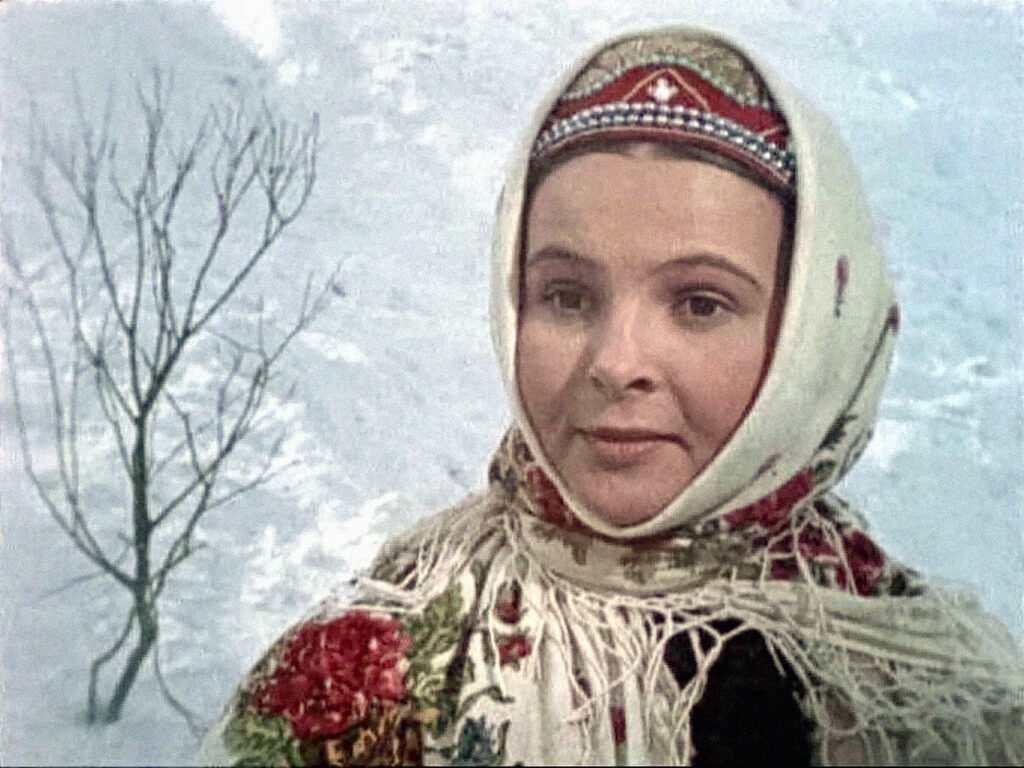
On Christmas Eve the Devil (Georgy Millyar) descends on a remote village to stir up mischief. In the same village, the pious painter and blacksmith Vakula (Yuri Tavrov) finds his romantic advances towards the beautiful Oksana (Lyudmyla Myznikova) rebuffed. While Oksana leaves Vakula to go caroling, the Devil finds himself the victim of the farcical sexual intrigues of the witch Solokha (Lyudmila Khityaeva) who also happens to be Vakula’s mother. Through a series of comic coincidences, Vakula traps the Devil, saddles him, and harnesses his powers to fly to St. Petersburg to collect the slippers of the Tsarina and win the hand of Oksana.
The Night Before Christmas (1961) is an adaptation of a short story by Nikolai Gogol, inspired by Ukrainian folklore, from the collection Evenings on a Farm Near Dikanka. The film was produced by the Gorky Film Studio and was written and directed by Aleksandr Rou who is best known for his other collaborations with “Baba Yaga” actor Georgy Millyar Father Frost (1964) and The Golden Horns (1974). Rou made many types of films for Gorky Film Studio, but his specialty was always the fairytale or folklore family film.
This breed of Russian films combined farcical and slapstick comedy with fantastic adventures. Aesthetically these films draw their inspiration from the early color animations of Walt Disney that Sergei Eisenstein so enthusiastically championed. The Night Before Christmas, like other Soviet fantasy films, was shot almost entirely on sound stages in deep, warm shades of red, blue and green. These fantasy films employed classic practical effects to achieve their wondrous spectacles; from double exposures to playing shots in reverse.
Rou, an accomplished film artist in this medium, demonstrates in The Night Before Christmas an aptitude for balancing the spectacle of fantasy with the more earthy comedy. The gags in The Night Before Christmas are predicated on happenstance that weaves a complex narrative web throughout the film. Early on the Devil attempts to saddle Vakula only for Vakula to saddle him later in the film. Likewise the French Farce of the Oksana sequence pays off later in both the climax at the church as well as during the late hours of caroling and sledding.
The way that different characters’ subplots weave in and out of each other’s trajectories is lifted directly from the structure of the source material. Unlike many of the Russian fantasy films of this period, The Night Before Christmas emphasizes an ensemble. It’s a film about a town rather than some lone hero or maiden pitted against a malevolent force. The Night Before Christmas can easily be read as a highly stylized snapshot of a Russian community; one that trades in caricature and mythology rather than socialist realism or human complexity.
The Night Before Christmas is most notable today for its outrageous turn from actor Georgy Millyar as well as its treatment of the character Solokha. Solokha is a promiscuous woman who practices magiks yet she is never shamed, scolded or punished. In fact, her sexual prowess and prolific love life is celebrated by her many lovers. It’s a cultural idiosyncrasy distinct in Gogol’s work that was carried over into the film and imbues it with a more contemporary sensibility.
However, the greatest pleasure a film like The Night Before Christmas offers is its highly stylized sequences of fantasy. Images of Vakula riding on the devil’s back through the night sky or Solokha picking stars out of the heavens are the stuff that dreams are made of. That The Night Before Christmas looks like a children’s book of illustrations come to life is no accident. The Night Before Christmas was meticulously designed and executed by Rou and company. The result is one of the most beautiful films in the Soviet fairytale film canon.
